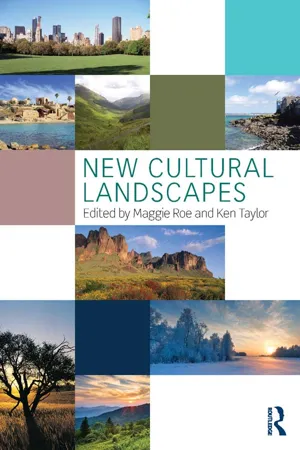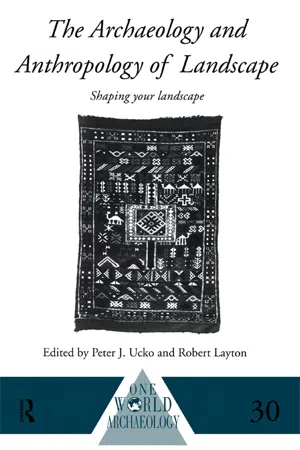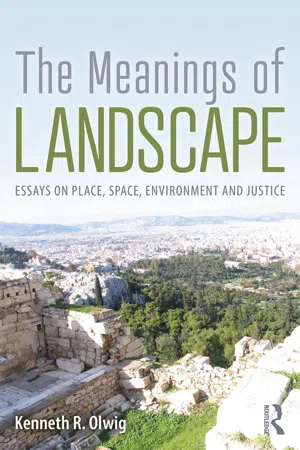Cultural Landscapes
Cultural landscapes refer to the visible human imprint on the environment, encompassing the physical, ecological, and cultural elements of a place. They reflect the interactions between people and their surroundings, including built structures, agricultural patterns, and symbolic features. Cultural landscapes are shaped by human activities and hold significant historical, aesthetic, and social value.
6 Key excerpts on "Cultural Landscapes"
- eBook - ePub
Seeing Cities Change
Local Culture and Class
- Jerome Krase(Author)
- 2016(Publication Date)
- Routledge(Publisher)
...Cultural Landscapes can range from thousands of acres of rural land to homesteads with small front yards. They can be man-made expressions of visual and spatial relationships that include grand estates, farmlands, public gardens and parks, college campuses, cemeteries, scenic highways, and industrial sites. Cultural Landscapes are works of art, texts and narratives of cultures, and expressions of regional identity. They also exist in relationship to their ecological contexts” (2009). The Geographer Carl O. Sauer had perhaps the greatest impact on a broad spectrum of social and cultural studies by emphasizing the power of humans to modify the visible features of the Earth’s surface and in the process create Cultural Landscapes. For early German geographers, the term Landschaft (landscape) was an area identified by visible, physical, and cultural features. The work of Sauer and others at the Berkeley School of Cultural Geography expanded the scope of geography by reducing the environmental determinism that had dominated the study of landscapes by geographers. Historically, the study of Cultural Landscapes was essentially a national project that focused especially on the lasting effects of founding cultural groups. In the United States the founding groups were its earliest Anglo-Saxon settlers. As a result, the search for the quintessential “American” character showed an historical small town and rural bias. Later immigrants, especially those who came to America after the middle of the nineteenth century, were seen as environmental interlopers and their impact on America’s Cultural Landscape was generally viewed as a mere modification of that which was already established. However, except perhaps for those of Native Americans, all of America’s building traditions have come from abroad...
- eBook - ePub
Conserving Cultural Landscapes
Challenges and New Directions
- Ken Taylor, Archer St. Clair, Nora J. Mitchell, Ken Taylor, Archer St. Clair, Nora J. Mitchell(Authors)
- 2014(Publication Date)
- Routledge(Publisher)
...The UNESCO Recommendation on the Historic Urban Landscape (HUL), approved by the 17th General Assembly of UNESCO in November 2011, extends an interdisciplinary cultural landscape approach to urban settings as a way to engage with the multiple aspects of urban historic conservation rather than a focus predominantly on architectural elements. The chapters in this book articulate this evolving concept and new directions in conservation of Cultural Landscapes and illustrate, through many case studies, how landscape meaning and human values are conceived and acted upon in different places across the world. Cultural Landscape: A Useful and Evolving Concept Cultural Landscapes are the places where human culture is on display where ‘our human landscape is our unwitting biography, reflecting our tastes, our values, our aspirations, and even our fears in tangible visible form’ (Lewis 1979:12). Cultural Landscapes consist therefore of tangible physical patterns and elements, but also importantly, reflect intangible values and associations. Cultural Landscapes are a window onto our past, our present and our future and our evolving relationship with the natural environment. Inextricably tied to this notion is that of landscape as process, rather than merely as product (Selman 2012 ; Taylor 2012). It is an understanding of landscape ‘as a process by which identities are formed’ (Mitchell 1994 :1). Such a view of landscape—landscape as cultural construct—embraces not only the physical, practical ways in which people shape and structure their landscapes through time, but also seeks to understand the significance of the beliefs, values and ideologies that people bring to the shaping of landscape. In cultural landscape studies there are two consistent questions that the critical mind asks...
- eBook - ePub
- Maggie Roe, Ken Taylor, Maggie Roe, Ken Taylor(Authors)
- 2014(Publication Date)
- Routledge(Publisher)
...1 New Cultural Landscapes Emerging issues, context and themes Maggie Roe and Ken Taylor It is the landscape as a whole – that largely manmade tapestry, in which all other artefacts are embedded. . . which gives them their sense of place. (Lowenthal 1975: 12) Introduction Internationally there is a widening interest academically, professionally and in the community at large in the concept and meaning of landscape, rural and urban, as the setting for everything we do. Whilst there are many landscapes, we tend to refer to landscape in the singular, but that is expressive of a multitude of settings. Landscape is therefore a ubiquitous entity: we live in it, pass through it every day, and it thereby affects our lived experiences tangibly and intangibly. We shape it and it shapes us. It is a value-laden entity. We see landscape continuously; nevertheless landscape is not simply what we see, a kind of transient static scenery vacuously experienced with detached contemplation. Rather it is as Cosgrove suggests (1998 [1984]: 1): a way of seeing that has its own history, but a history that can be understood only as part of a wider history of economy and society; that has its own assumptions and consequences, but assumptions and consequences whose origins and implications extend well beyond the use and perception of land; that has its own techniques of expression, but techniques which it shares with other areas of cultural practice. Variously described as an important but ambiguous term (Meinig 1979) and a slippery term (Stilgoe 1982), landscape, as Lowenthal (2007) declared, is everyone’s heritage and an essential part of our patrimony. In this sense therefore and increasingly across the spectrum of interest in landscape the term ‘cultural landscape’ has firmly taken root...
- eBook - ePub
The Archaeology and Anthropology of Landscape
Shaping Your Landscape
- Robert Layton, Peter Ucko, Robert Layton, Peter Ucko(Authors)
- 2003(Publication Date)
- Routledge(Publisher)
...29 Archaeology and the evolution of Cultural Landscapes: towards an interdisciplinary research agenda JAMES MCGLADE Introduction Recent decades have seen a steady rise in the use, exploitation and conflict within the Cultural Landscapes of Europe. Much of this is a consequence of the development of modern market systems, increasing land-use conflicts, and an exponential growth in mass tourism, as western society experiences an unprecedented increase both in disposable income and in leisure time. The mobility and insatiable curiosity that have accompanied this latter exercise in ‘cultural’ consumption must be treated, not with cynical censure, but with realistic proactive schemes. The commercial marketing of historical landscapes throughout Europe is by now an irreversible phenomenon, as is the desire to ‘curate’ them, as witnessed by the construction of archaeological parks, eco-museums and the creation of ‘reserves’; the construction of a new species of landscape is afoot—a new partitioning (legally sanctioned by the Malta Convention) in which cultural/historical spaces are separated out from the wider context of the living landscape and packaged for consumption (Bender 1992; Kolen 1995). The real problem with such schemes is that they tend to reflect official views of the past and, more contentiously, a single knowable past (cf. Lowenthal 1985). The relative ease with which these attitudes can be deconstructed has generated an entire academic industry over the last decade, encompassing archaeology, anthropology and geography. However, critique is of itself facile and ultimately of only academic interest unless it promotes constructive alternatives. A primary argument of this chapter is that practical alternatives can be found in the promotion of integrative planning and management structures that do not regard scientific and local knowledge structures as mutually exclusive, but promote a rapprochement between them...
- Nuala C. Johnson, Richard H. Schein, Jamie Winders(Authors)
- 2013(Publication Date)
- Wiley-Blackwell(Publisher)
...This chapter is not, however, meant as a comprehensive introduction to the subdiscipline of cultural geography. Instead, it is an invitation to examine the field’s ever-changing contours through the ensuing essays. Cultural geography has been a foundational building block of human geography since the discipline formally was established in the nineteenth century. Documenting spatial patterns in human interaction with, responses to, and transformations of the natural landscape, raising questions about how landscape itself was shaped by and shaped social dynamics, and problematizing the ideas of culture, landscape, and nature have been cultural geography’s contributions to the ways that human geographers have thought about the world around them, past and present. Today, the line between human geography as a discipline and cultural geography as a subdiscipline is blurred to the point that cultural geography is human geography in some corners of our field. Recent intellectual and scholarly developments within geography have drawn cultural geographers closer to the fold and to deeper engagements with colleagues and ideas once thought beyond cultural geography’s purview – political, economic, historical, or environmental geography, for example. These connections have been strengthened through cultural geography’s embrace of and relevance to the so-called cultural and spatial turns across the human sciences as well as its engagement with social theory and concepts of interest to a broad range of scholars within and beyond the discipline. In short, cultural geographers today study nearly every aspect of human geography and do so in ways that simultaneously reinforce the subdiscipline’s place in geography and question the logic and locations of its boundaries. Cultural geography is itself deeply geographic in terms of what places and spaces cultural geographers study and how cultural-geographic scholarship is conducted across institutional and national contexts...
- eBook - ePub
The Meanings of Landscape
Essays on Place, Space, Environment and Justice
- Kenneth R. Olwig(Author)
- 2019(Publication Date)
- Routledge(Publisher)
...A landscape is a gathering in the making. This definition lends itself to analysis of many of the problems which landscape studies can address. Landscapes are both imaginative and material; they encompass physical geographies, phenomenologies, and cultural and political commitments. (Tsing 2017:7) This book is concerned with the causes of the transition from the first sense of landscape, as polity and place, to the second sense of landscape, as spatial scenery, and its consequences for the understanding of place and space, and the use and abuse of nature and justice. In this context it is important to understand the way the concept of nature came to be conflated with that of landscape. The “nature” of landscape The idea of landscape as pictorial, spatial scenery emerged during the Renaissance and Enlightenment at about the same time as nature came to be similarly defined as scenery, so that the two concepts effectively often merged. Coming from the Latin word for “birth,” nature had originally been thought of as a behind-the-scenes generative force manifested by the fertile combination of elements that brings about life, and which determines something’s normal inborn character or “nature.” Nature thereby also had a powerful normative meaning differentiating the natural from the unnatural; that which fosters life, and that which fosters death. To the ancients, nature develops as an embryonic principle of growth and fertility in a circular way from birth to childhood to maturity and thence to death and rebirth. In classical Greece and Rome, and throughout most of the subsequent European history, pastoral society was identified with a natural state of being. This is because pastoral society was seen as based on an ideally harmonious and fertility generating interaction both among people as a community sharing common resources and between humans, animals, plants, and the soil of the common lands that they shaped together as a substantive landscape...





